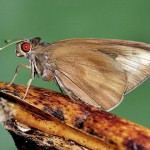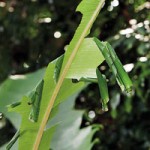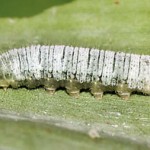News
Enter the Banana Skipper butterfly; bad news for banana farmers
Butterflies are beautiful, innocent creatures loved by all. But the larvae of the latest addition to Sri Lanka’s list of butterflies could become a pest to banana plants, warns the young butterfly enthusiast who discovered it.
Tharindu Ranasinghe had observed the larvae of this butterfly, identified as Banana Skipper, for the first time, on September 6, in his home garden in Kandumulla in Yakkala. He observed a tube-like formation in the Banana leaves.

The red-eyed Banana Skipper
A closer inspection revealed a worm-like caterpillar taking refuge in these tubes. A single bananaleaf had about 3-4 larvae and the entire plant had as many as 22-25 such creatures. A subsequent study revealed many other banana plants had been infested by these caterpillars.
| Butterfly diplomacy India’s Maharashtra state recently selected the Blue Mormon (Papilio polymnestor) found in India and Sri Lanka as their state butterfly. The Blue Mormon is a large and beautiful butterfly that sports velvet black wings with bright blue spots. In Sri Lanka, they are second only to the Sri Lanka Birdwing –Sri Lanka’s National Butterfly. India’s media reported that Maharashtra State’s Forest Minister Sudhir Mungatiwar announced that his department would be collaborating with the Sri Lankan government to study the species in detail. The report claims Mahashastra’s forest minister Mungantiwar and Sri Lankan ambassador Saroja Sirisena have requested this country’s assistance for the study. The report quoting a forest ministry official said, “Once complete, papers will be published and measures will be implemented to promote the butterfly in the state as well as in Sri Lanka,” Last year Sri Lanka, too, named a butterfly for each of the 9 provinces to raise awareness of these beautiful insects. |
Tharindu identified that the ‘tube maker’ belonged to a group of butterflies known as Skippers. Tharindu also alerted Himesh Jayasinghe – a member of the Butterfly Conservation Society of Sri Lanka of this discovery.
Himesh who lived in Yatihena in Malwana, also observed similar larvae on banana plants in his area. Since it was important to verify what would emerge from these larvae the young enthusiasts collected a few samples and put them in glass containers.

Eaten Banana leaf
They took good care of the caterpillars by cleaning the excrement and giving them banana leaves regularly. After a few days, a butterfly with unique red eyes emerged from the cocoon.
A Skipper or the Skipper butterfly belongs to the family of Hesperiidae. They are named after their quick, darting flight habits. The butterfly enthusiasts soon realised that the butterfly was different from the other three species of ‘red eyed’ butterflies scientifically categorised under the genus Erionota.
These are already recorded in Sri Lanka as the Common Red-eye, Giant Red-eye and Banded Red-eye. The Common Red-eye caterpillars are found on Bamboo varieties while the other two lay eggs on cane plants.
When the two enthusiasts studied the feeding patterns, the technique of rolling banana leaves and other features of the new red-eye they were found to be different to the behaviour of the species that belong to Erionota torus or Erionota thrax but showed patterns similar to the Banana Skipper.
| Beware of ornamental plants In addition to the Banana Skipper, two other exotic butterfly species are here to stay through the importation of ornamental plants. They include the Orange Migrant (Catopsilia Scylla) and the Yellow Palm-dart (Cephrenes trichopepla). It is feared that many other unknown insects and micro-organisms that could become invasive species, could come via the exchange of plants. Experts warn that these plants should be quarantined before they are introduced to the native soil as they could pose a threat to our wildlife. It is important that the Sri Lanka Customs continues to raid plant materials that are imported without proper quarantine procedures. In the past few months Customs had made such detentions. |
Since over the years there has been confusion over the identification of these two species even in its adult stage, further studies and bar coding should be carried out to clarify the exact species, the young researchers say.

The larvae
Until now this butterfly species was not known to farmers here nor found in the literature, so it is believed that the Banana Skipper could be a fairly new arrival to Sri Lanka. The Banana Skipper is found in India and in some East-Asian counties.
Researchers believe the species could have come here with imported banana varieties. Ornamental Banana plants too are imported to Sri Lanka as a garden plant, and the eggs or larvae of this butterfly could easily have come into the country this way too, they say.
The adult butterflies may also be crossing over from India to Sri Lanka on fishing boats as butterflies are attracted to the light from the lamps of these boats.
The young enthusiasts later found larvae infected banana trees in areas including Kaduwela and Soragune. So although they are not yet commonly found, the Banana Skipper may not be good news for banana farmers as they could easily turn into an invasive species.
A n immediate study should be done on the distribution of this butterfly in Sri Lanka and agriculture specialists should annalyse whether it was becoming a pest.
The two young butterfly enthusisasts plan to carry out research on the Banana Skipper and have asked the public to alert them if they find the leaf rolling larvae on banana plants.
They can be contacted on 0718181225 / 0779914227 or through email butterflycssl@gmail.com.

